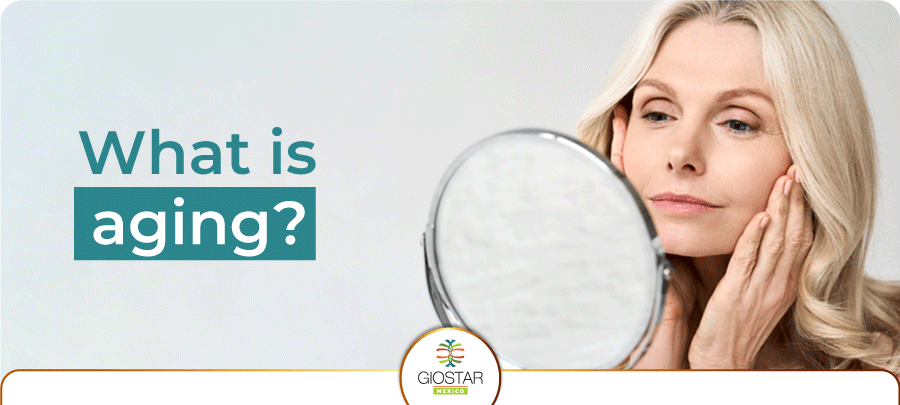What is Aging?

Aging is a natural and inevitable process that all living beings experience. It involves the gradual decline of bodily functions and biological processes over time, resulting in a range of changes in the body such as reduced organ function, decreased mobility, and increased susceptibility to disease. Understanding the causes and effects of aging is important, as it has a significant impact on the health and well-being of individuals. In this blog, we will delve into the underlying mechanisms of aging, common diseases associated with aging, and emerging therapies aimed at combating the effects of aging.
What is aging?
Aging is the process of gradual decline in bodily functions and biological processes that every living being experiences. While the exact causes of aging are not fully understood, a combination of genetic, environmental, and lifestyle factors are thought to play a role, leading to changes in the body such as reduced organ function, decreased mobility, and increased susceptibility to disease.
It is essential to understand aging as it significantly impacts the health and well-being of individuals, making them more susceptible to chronic diseases like heart disease, cancer, and dementia. By studying aging and its underlying causes, scientists and healthcare professionals can develop new treatments and interventions to help people age more healthily and prevent or delay the onset of age-related diseases. Furthermore, understanding aging can help society prepare for the changing demographics of aging populations and develop policies and practices to better support older adults.
Why do we age?
Aging is a complex process influenced by a multitude of factors, and its underlying mechanisms are not yet fully understood. However, it is widely accepted that aging is caused by a combination of genetic and environmental factors, which lead to a progressive decline in bodily functions and cellular processes. One of the main theories of aging is the “free radical theory of aging,” which suggests that aging is caused by the accumulation of cellular damage caused by free radicals, unstable molecules that can cause oxidative damage to cells and DNA.
As the body ages, there is a gradual decline in the function of individual cells, which can lead to a wide range of health issues. For example, a decline in the function of immune cells can lead to an increased susceptibility to infections and cancers. Additionally, there is an accumulation of damage in the DNA over time, which can lead to genetic mutations and an increased risk of cancer. Other changes that occur with aging include the development of chronic inflammation, changes in the metabolism, and a decline in tissue regeneration. These changes ultimately lead to a loss of overall physiological function and an increased risk of disease.
Aging diseases
Aging is associated with an increased risk of a variety of diseases, including cardiovascular diseases, cancer, and neurodegenerative diseases. Cardiovascular diseases, such as heart disease and stroke, are the leading cause of death among older adults. The risk of developing these diseases increases with age, as does the risk of developing risk factors such as high blood pressure, high cholesterol, and diabetes. Cancer is also more common in older adults, with age being one of the strongest risk factors for the disease. Additionally, neurodegenerative diseases, such as Alzheimer’s and Parkinson’s disease, are more prevalent in older adults, and the risk of developing these diseases increases with age.
As people age, they become more susceptible to chronic diseases that can have a significant impact on quality of life. Understanding the underlying mechanisms of these diseases and how they are related to aging is crucial for developing new treatments and interventions to improve the health and well-being of older adults. For example, recent research has shown that cellular senescence, a process in which cells stop dividing and become damaged, may contribute to the development of many age-related diseases, including cardiovascular diseases and neurodegenerative diseases. Targeting this process may hold promise for developing new treatments for these diseases.

Stem cell therapy for anti-aging
Stem cell therapy is a promising approach for anti-aging treatments. Stem cells have the ability to renew themselves through cell division and develop into different cell types in the body, making them a potentially effective treatment for age-related diseases such as Parkinson’s disease, Alzheimer’s disease, and heart disease. Stem cells can be harvested from various sources, like umbilical cords, adult tissues from healthy donors, and used to regenerate damaged tissues and organs.
Recent research has shown that stem cells can slow down the aging process and improve the quality of life in older adults. Also stimulate the production of collagen and elastin, key components of skin health, making them a promising option for anti-aging treatments that promote skin regeneration and reduce the appearance of fine lines and wrinkles.
How much does stem cell therapy cost?
The cost of Stem Cell Therapy needs to be determined by our expert medical team, as prices depend on the specific condition and personalized medical recommendations. Our dedicated team of medical professionals carefully evaluates each patient’s unique health situation to recommend the most effective therapy. Stem Cell Therapy includes the following:
- Laboratory protocol by Dr. Anand (activation of the stem cells to direct them towards the affected tissue or organ)
- 1 – 3 stem cell vials (35 – 105 million stem cells)
- 1 – 10 billion exosomes (volume depends on the doctor’s personal evaluation of each patient)
- Oxygen Therapy
- Body preparation
- Medical Consultation
- Dietitian Follow-up post-therapy
- Transportation hotel-clinic in local shuttle
- Lodging (available in our Clinic in Algodones) at Hotel Hacienda or Hotel Cielito Lindo
- Preferential prices for future reinforcements/applications
References:
Austad, S. N., & Fischer, K. E. (2016). Sex Differences in Lifespan. Cell metabolism, 23(6), 1022-1033. https://doi.org/10.1016/j.cmet.2016.05.019
Burt, R. K., & Testori, A. (2015). Stem cell therapy for age-related diseases. Frontiers in cell and developmental biology, 3, 2. https://doi.org/10.3389/fcell.2015.00002


